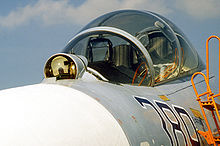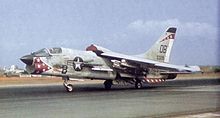From Wikipedia, the free encyclopedia
IRST is a generalized case of forward looking infrared (FLIR), i.e. from forward-looking to all-round situational awareness. Such systems are passive, meaning they do not give out any radiation of their own, unlike radar. This gives them the advantage that they are difficult to detect.
However, because the atmosphere attenuates infra-red to some extent (although not as much as visible light) and because adverse weather can attenuate it also (again, not as badly as visible systems), the range compared to a radar is limited. Angular resolution at short ranges is better than radar due to the shorter wavelength.
Contents
Early systems
The first use of an IRST system appears to be the F-101 Voodoo, F-102 Delta Dagger and F-106 Delta Dart interceptors. The F-106 had an early IRST mounting replaced in 1963 with a production retractable mount.[2] The IRST was also incorporated into the Vought F-8 Crusader (F-8E variant) which allowed passive tracking of heat emissions and was similar to the later Texas Instruments AAA-4 installed on early F-4 Phantoms.[3]The F-4 Phantom had an Texas Instruments AAA-4 infrared seeker[4] under the nose of early production aircraft F-4B's, and F-4C's and not installed on later F-4-D's due to limited capabilities[5] but retained the bulge and indeed some F-4D's had the IRST receiver retrofitted in a modified form.[3] The F-4E eliminated the AAA-4 IRST bulge and received an internal gun mount which took up the area under the nose.[6] The F-4J also eliminated the AAA-4 IRST receiver and bulge under the nose.[7]
The Swedish Saab J-35F Draken (1965) also used an IRST, a Hughes Aircraft Company N71.
These were fairly simple systems consisting of an infra-red sensor with a horizontally rotating shutter in front of it. The shutter was slaved to a display under the main interception radar display in the cockpit, any IR light falling on the sensor would generate a "pip" on the display, in a fashion similar to the B - scopes used on early radars.
The display was primarily intended to allow the radar operator to manually turn the radar to the approximate angle of the target, in an era when radar systems had to be "locked on" by hand. The system was considered to be of limited utility, and with the introduction of more automated radars they disappeared from fighter designs for some time.
Later systems
IRST systems re-appeared on more modern designs starting in the 1980s with the introduction of 2-D sensors, which cued both horizontal and vertical angle. Sensitivities were also greatly improved, leading to better resolution and range.The best known users of modern IRST systems are:
 Russia
Russia
- Su-27 Flanker (OLS-27/30/35)[8]
- Mikoyan MiG-29 (OLS-29)[8]
 United States
United States
- Grumman F-14 Tomcat (AN/AAS-42 IRST)[9]
- Lockheed Martin F-35 Lightning II AN/AAQ-37 electro-optical Distributed Aperture System (DAS) with a 360 degree IRST, missile detection/warning, and day/night vision capabilities, designed and produced by Northrop Grumman Electronic Systems.
- Boeing F/A-18E/F Super Hornet
 Sweden
Sweden
- Saab JAS 39 Gripen (SELEX Galileo IRST) [10]
 Europe
Europe
- Eurofighter Typhoon (PIRATE)[11][12]
 France
France
- Dassault Rafale (OSF)[13]
 China
China
- Chengdu J-10 and JF-17 Thunder. Sichuan Changhong Electric Appliance Corporation,
With infra-red homing or fire-and-forget missiles, the aircraft may be able to fire upon the targets without having to turn their radar sets on at all. Otherwise, they can turn the radar on and achieve a lock immediately before firing if desired. They could also close to within cannon range and engage that way.
Whether or not they use their radar, the IRST system can still allow them to launch a surprise attack.
An IRST system may also have a regular magnified optical sight slaved to it, to help the IRST-equipped aircraft identify the target at long range. As opposed to an ordinary forward looking infrared system, an IRST system will actually scan the space around the aircraft similarly to the way in which mechanically (or even electronically) steered radars work. The exception to the scanning technique is the F-35 JSF's DAS, which stares in all directions simultaneously, and automatically detects and declares aircraft and missiles in all directions, without a limit to the number of targets simultaneously tracked.
When they find one or more potential targets they will alert the pilot(s) and display the location of each target relative to the aircraft on a screen, much like a radar. Again similarly to the way a radar works, the operator can tell the IRST to track a particular target of interest, once it has been identified, or scan in a particular direction if a target is believed to be there (for example, because of an advisory from AWACS or another aircraft).
Note that, like infra-red homing seekers, an IRST is more likely to detect a target with its engine exhaust pointed towards the detector than away from it. This means that many jet aircraft will be detected at longer ranges if they are flying away from the IRST-equipped aircraft rather than towards it. However, most IRST systems are sensitive enough to detect the heat of a jet from head-on as well, either infra-red energy generated from the hot air coming out of the engines, from air friction heating the airframe, or both.
IRST systems can incorporate laser rangefinders in order to provide full fire-control solutions for cannon fire or launching missiles. The combination of an atmospheric propagation model, the apparent surface of the target, and target motion analysis (TMA) IRST can calculate the range.


No comments:
Post a Comment